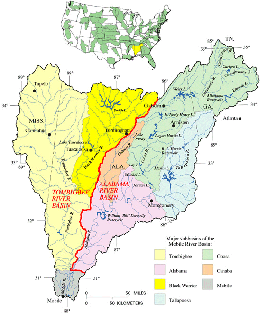| To the FWGNA group: The fauna of the Mobile Basin has become a cause célèbre - perhaps the cause célèbre - of freshwater gastropod conservation in North America. I am aware of four general calls-to-arms issued in recent years that have focused on the plight of this famously diverse biota, inhabiting creeks and rivers through the length of Alabama, edging into East Mississippi and North Georgia (1). The review of Neves and his colleagues, for example, catalogued 118 freshwater gastropod species in the Mobile Basin in  ten
families, suggesting that as many as 38 may have been lost to
extinction in the 20th century, with another 70 threatened. Yet
only seven of the species remaining are currently protected under
the US Endangered Species Act: four pleurocerids (Leptoxis ampla, L. plicata, L. taeniata, Goniobasis crenatella), two viviparids (Tulotoma magnifica and Lioplax cyclostomaformis) and one hydrobiid (Lepyrium showalteri). ten
families, suggesting that as many as 38 may have been lost to
extinction in the 20th century, with another 70 threatened. Yet
only seven of the species remaining are currently protected under
the US Endangered Species Act: four pleurocerids (Leptoxis ampla, L. plicata, L. taeniata, Goniobasis crenatella), two viviparids (Tulotoma magnifica and Lioplax cyclostomaformis) and one hydrobiid (Lepyrium showalteri).Now after a hiatus of over ten years, in late June the US Fish and Wildlife Service announced a proposal to list two new Mobile Basin pleurocerids: Leptoxis foremani and Pleurocera foremani (2). The comment period ends this Friday, August 28. Any of our colleagues on this list who might wish to offer "comments, suggestions, and any additional information on biology, threats, range, distribution, population size, or current or planned activities and the activities' possible impacts on these species or their proposed critical habitats" will find instructions on the FWS website [here]. But what do we actually know about the freshwater gastropods of the Mobile Basin? Their taxonomy almost entirely predates the Modern Synthesis. We have seen that Calvin Goodrich, for example, seemed to have second thoughts about the 26 species of Leptoxis he catalogued in 1922 (3), later coming around to the realization that much of the shell variation expressed in North American pleurocerids may be ecophenotypic in origin (4). A bit of digging into the 6/29 issue of the Federal Register that formally proposes the new pleurocerids for listing will reveal a reference to the recent dissertation of Jeffrey Sides, reporting negligible sequence difference between P. foremani and a co-occurring species of an entirely different genus, Goniobasis ("Elimia"). What gives? This is the first in what will probably turn out to be a sporadic series of essays on the freshwater gastropod fauna of the Mobile Basin. Between the undeniably fascinating evolutionary biology of this unique fauna and the complications of politics, personalities, and public policy there are, no doubt, many lessons to be learned. We'll keep in touch, Rob Notes (1) Brown, K. M & P. D. Johnson (2004) Comparative conservation ecology of pleurocerid and pulmonate gastropods of the United States. Amer. Malac. Bull. 19: 57-62. Lydeard, C. et al. (2004) The global decline of nonmarine mollusks. BioScience 54: 321 - 330. Neves, R.J., A E. Bogan, J. D. Williams, S. A. Ahlstedt, and P. W. Hartfield (1997) Status of aquatic mollusks in the southeastern United States: A downward spiral of diversity. Chapter 3 in Aquatic Fauna in Peril: the Southeastern Perspective (Benz & Collins, eds.) Southeast Aquatic Research Institute Publication 1. Lydeard, C. & R. L. Mayden (1995) A diverse and endangered aquatic ecosystem of the southeast United States. Conservation Biology 9: 800-805. (2) Service Proposes Endangered Species Status and Critical Habitat Designations for the Georgia Pigtoe Mussel, Interrupted Rocksnail, and Rough Hornsnail: http://www.fws.gov/southeast/news/2009/r09-035.html (3) Goodrich, C. (1922) The Anculosae of the Alabama River drainage. Misc. Publ. Mus. Zool. Univ. Mich., 7, 1-57 (4) The legacy of Calvin Goodrich. FWGNA Archives 23Jan07 Goodrichian Taxon Shift. FWGNA Archives 20Feb07 |